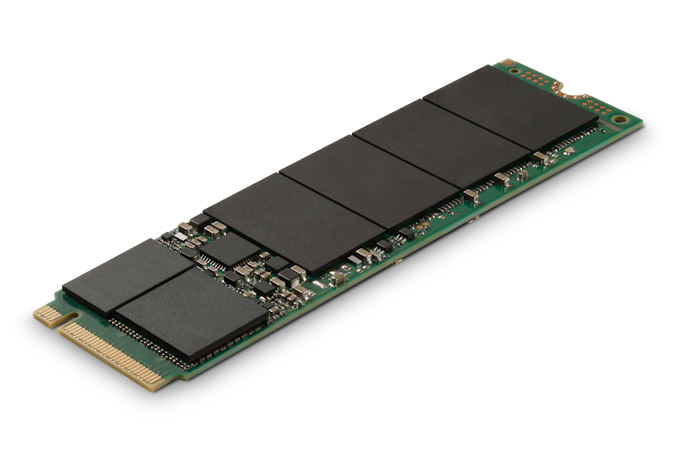Micron Introduces 2200 Client NVMe SSD With New In-House Controller
by Billy Tallis on March 18, 2019 1:00 PM EST
Micron has announced the first product based on their new in-house client NVMe SSD controller. The Micron 2200 doesn't boast performance sufficient to compete with the top enthusiast-class NVMe drives on the retail market, but should be plenty fast enough for OEMs and system integrators to use it as a performance option in the business PCs it is intended for.
Micron has been notably slow about bringing NVMe to their client and consumer product lines. They initially planned to launch both client OEM and consumer retail drives built around the combination of their first-generation 32-layer 3D NAND and the Silicon Motion SM2260 controller, but those plans were shelved as it became clear that combination could not deliver high-end performance. Last fall Micron finally launched the Crucial P1 entry-level NVMe SSD with QLC NAND and the SM2263 controller, but no high-end product has been announced until now.
It's been no secret that Micron has been working on their own NVMe SSD controllers. Every other NAND manufacturer has either developed in-house controllers or acquired a controller vendor, and complete vertical integration has worked out extremely well for companies like Samsung. Micron has been the odd man out sourcing all their controllers from third parties like Silicon Motion, Marvell and Microsemi, but their 2015 acquisition of startup controller design firm Tidal Systems made their intentions clear. That acquisition and any other in-house controller design efforts bore no visible fruit until Flash Memory Summit last year, when a prototype M.2 client NVMe SSD was quietly included in their exhibits.
| Micron 2200 Specifications | |||||
| Capacity | 256 GB | 512 GB | 1 TB | ||
| Form Factor | M.2 2280 Single-Sided | ||||
| Interface | NVMe PCIe 3 x4 | ||||
| Controller | Micron in-house | ||||
| NAND | Micron 64-layer 3D TLC | ||||
| Sequential Read | 3000 MB/s | ||||
| Sequential Write | 1600 MB/s | ||||
| 4KB Random Read | 240k IOPS | ||||
| 4KB Random Write | 210k IOPS | ||||
| Power | Active | 6 W | |||
| Idle | 300 mW | ||||
| Sleep | 5 mW | ||||
| Warranty Endurance | 75 TB | 150 TB | 300 TB | ||
Micron has not yet shared details about their new NVMe controller, but the basic specs for the 2200 SSD are available. The 2200 uses Micron's 64-layer 3D TLC NAND flash memory and offers drive capacities from 256GB to 1TB as single-sided M.2 modules. The drive uses a PCIe gen 3 x4 interface and has the expected features for a Micron client drive, including power loss protection for data at rest and SKUs with or without TCG Opal self-encrypting drive (SED) capabilities.
The performance and write endurance ratings for the Micron 2200 don't match up well against top consumer drives, but compare favorably against entry-level NVMe SSDs. Endurance is actually lower than their Crucial MX500 mainstream consumer SATA drive, so any retail derivative of the 2200 will need to improve on that metric. No such retail version has been announced, but with the 2200 available now it is likely we'll be hearing from Crucial within a few months, though they may wait until later in the year to launch with 96 layer NAND instead of 64 layer.










14 Comments
View All Comments
abufrejoval - Tuesday, March 19, 2019 - link
The fact that most of these cards don't offer what you think: They may just offer one actual PCEe M.2 connector while the others are nothing but holding brackets that connect SATA M.2 SSDs to sata ports on the motherboard.What you probably expect is a PCIe switch, which allows you to multiplex those PCIe lanes and use the full bandwidth for one SSD at one time, even if the aggregate bandwidth cannot exceed that of a single device.
What some might deliver is bifurication or even quadfurication if it were to be a x16 device, but that requires support from the motherboard hardware and BIOS, which btw. is also the case for the PCIe switch and that is the main reason why meaningful solutions do either not exist, are not bootable or outrageously expensive (Avago-Broadcom driving prices for switch chips through the roof).
With the PCIe lanes being limited as they are on desktop CPUs, there has to be either static partitioning (x-furication) or multiplexing. It can take the form of SATA, which multiplexes bandwidth on the PCH link or it can be PCIe based switching: Connectors alone do not create bandwidth.
Dug - Wednesday, March 20, 2019 - link
I would think storage should/ could possibly be separated to a different lane like ram. You can add more ram without slowing down (to an extent). Instead of relying on PCIeBilly Tallis - Monday, March 25, 2019 - link
A multi-drop/shared parallel bus would not work well for storage. It only works for DRAM because of the short distances involved. Point-to-point serial links have proven superior everywhere else. A daisy-chained bus could provide most of the performance of PCIe but would add to the cost and pin count of every peripheral device, which is unreasonable when very few computers actually have more than about two PCIe peripherals.Booyaah - Tuesday, March 19, 2019 - link
I would need to see the pricing on this. Just from an IOPS perspective, the new 970 Evo+ is a good deal faster than this. So I don't really see it as news worthy really...maybe a head to head comparison would be better.